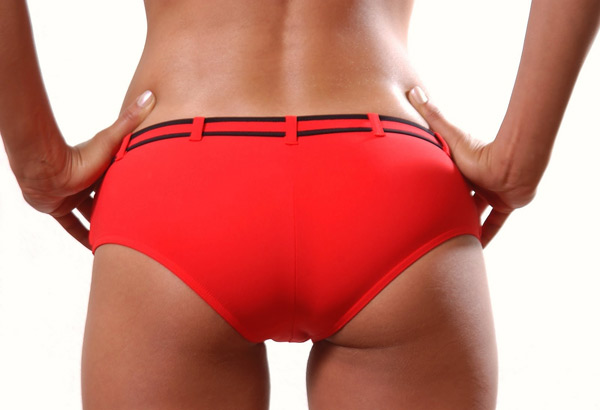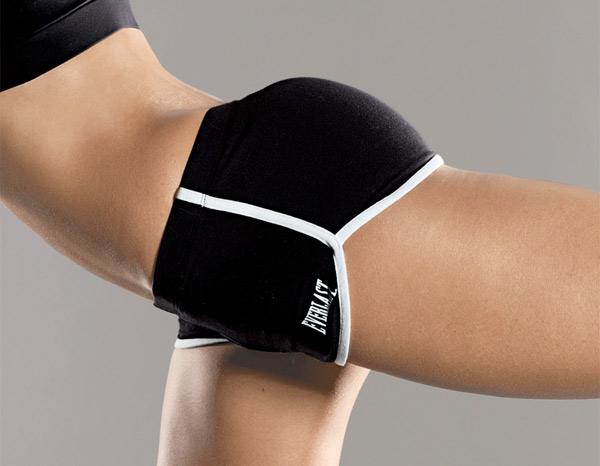
The gluteal muscles are a group of three muscles which make up the buttocks: the gluteus maximus, gluteus medius and gluteus minimus. The three muscles originate from the ilium and sacrum and insert on the femur.
The gluteus maximus is the largest of the gluteal muscles and one of the strongest muscles in the human body. It inserts at the iliotibial band and the gluteal tuberosity of the femur. Its action is to extend and to laterally rotate the hip, and also to extend the trunk.
The bulk of the gluteal muscle mass contributes only partially to shape of the buttocks. The other major contributing factor is that of the panniculus adiposus of the buttocks, which is very well developed in this area, and gives the buttock its characteristic rounded shape. Although the gluteal muscle bulk and tone can be improved with exercise, it is the disposition of the overlying panniculus adiposus which may be responsible for the “sagging butt” phenomenon.
Exercise in general (not only of the gluteal muscles but of the body in general) which can contribute to fat loss can lead to reduction of mass in subcutaneal fat storage locations on the body which includes the panniculus, so for leaner and more active individuals, the glutes will more predominantly contribute to the shape than someone less active with a fattier composition. The degree of body fat stored in various locations such as the panniculus is dictated by genetic and hormonal profiles.
Sitting for long periods can lead to the gluteal muscles atrophying through constant pressure and disuse. This may be associated with (although not necessarily the cause of) lower back pain, difficulty with some movements that naturally require the gluteal muscles, such as rising from the seated position, and climbing stairs.
Exercise and stretching
Any exercise that works and/or stretches the buttocks is suitable, for example lunges, hip thrusts, climbing stairs, fencing, bicycling, rowing, squats, arabesque, aerobics, and various specific exercises for the bottom.
Weight training exercises which are known to significantly strengthen the gluteal muscles include the squat, deadlift, leg press, any other movements involving external hip rotation and hip extension.
Glute Training For Women
Prioritize butt-building—namely getting your glutes beastly strong—and your entire body will look incredible. For that reason alone, it’s almost your duty to train that booty, and train it well. Here’s how to build stronger glutes and get that desired physique:

Pick Well For Your Posterior
Set up your workout regimen to directly correlate with the outcome you want. If you want a better booty—and more important—a better body, you need a program that matches that goal. Sounds simple, but so many workouts performed by women are way off the mark, even when they are designed specifically for women. Don’t even get me started on the typical “bro-gram” that many women do in the gym.
No lifter in her right mind can perform every lift under the sun. Just like power lifters need specific exercises to gear up for competition, you must carefully select the right exercises to achieve your desired results.
Above all else, choose exercises that heavily work the glutes. That immediately eliminates leg extensions, hack squats, or leg presses, which mostly target the quads. You can also get rid of machine leg curls, because the movements we’ll be doing will definitely work those hammies.
Anatomy of Glutes
The muscle fibers in your glutes are half fast twitch, half slow twitch. The glutes have multiple subdivisions and perform multiple roles. They play an integral role in basic movements including hip extension, abduction, external rotation, and posterior and anterior pelvic tilting. Your glutes are also responsible for hip and spine stabilization, posture improvement, and injury reduction in the hamstrings and hip joints. No wonder you can’t simply add a single glute exercise to your weekly workout routine and expect results.
When setting up your program, select four movements which work the glutes in various ranges without overworking the low back or quads. Choose one or two movements from each section of the above list. That way, you won’t unevenly hammer your quads or lower back. It’s also smart to put bridging movements first in the workout because they have the highest levels of glute activation. Feel the burn!
Pump Up Your Posterior
Glute pump/burn is an important aspect of training. If you’re not feeling the burn, you’re leaving room on the table for glute development. This is a vital aspect of strength training for women, and is likely one of the most overlooked aspects during a workout. Leave each workout with your glutes on fire. That’s the golden rule. Write it down. Do it.
Glute building is different than power lifting. Muscles don’t know weights, they respond to mechanical tension, metabolic stress, and muscle damage. It’s not about how much weight you can move, it’s about how much weight you can move with the glutes. Having said that, the stress you apply to your glutes needs to increase over time, whether that’s weight, time under tension, volume—whatever. You won’t improve your glutes if they never have to adapt to new stimuli.

Glutes Training Regimen
Sample workout to help you get started. Note that 66 percent of the exercises target the glutes from multiple angles. The remaining percentage involves compound upper body exercises.
For best results, do a full-body workout—one that includes glute work—four times per week. The regimen below is one example. Don’t focus on how long you train, but how efficiently. A typical training session can last between 45 and 60 minutes.
You might be concerned about sculpting a strong booty to fill out your favorite pair of jeans, but there’s so much more to a tight tush than the way your pants fit! Your backside consists of three major muscles: the glute maximum, glute medius, and glute minimus. This important group of muscles extends the hip (pulls the thigh behind you), abducts the hip (your lateral movement to the side), and does internal and external rotation of hip. In short, they’re incredibly important, but they’re often weak and underworked.
So many of our jobs require us to spend so much time sitting that our glutes “turn off” or stop firing as efficiently, effectively, and strongly as they should. Once our glutes stop firing, our hip flexors (the muscles that pull the thigh forward) get tight and can lead to injury. When you build a stronger booty, here are a few of the benefits you can expect.
Beat back pain: I couldn’t believe how much of my lower back pain dissipated after I started concentrating on building up my glute muscles. Your glutes work to stabilize the pelvis and keep integrity of movement in the hip joint. When they’re strong, your lower back doesn’t bear the brunt of your motion.
Increase athletic performance: If you want to be a stronger athlete, it’s time to start squatting. Stronger glutes will improve your speed, agility, and jumping skills, and quick side-to-side movements will also become much easier. Every time you take a step, your glute max shores up your pelvis and SI joint for stability. When you run, this is even more important, since the force of impact increases exponentially on each foot strike.
Prevent knee pain: Strong glute meds keep the pelvis stable from swaying side to side. When your pelvis isn’t stable, it puts a lot of pressure on your knees and ankles to compensate. When your backside is strong, it helps prevents this naturally, keeping you safe from injury.
Disclaimer
The Content is not intended to be a substitute for professional medical advice, diagnosis, or treatment. Always seek the advice of your physician or other qualified health provider with any questions you may have regarding a medical condition.